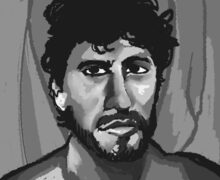SU Art Museum allows attendees to experience ecological art from home
Courtesy of Syracuse University Art Museum.
“Assembly: Syracuse University Voices on Art and Ecology” is being brought online. After opening on Jan. 25, the exhibit will be given another platform.
Get the latest Syracuse news delivered right to your inbox.
Subscribe to our newsletter here.
With a digital passport, e-museum attendees can visit different art periods, each unique in style and technique. One may find a print of a multi-toned city skyline, a watercolor portrait resembling the feminine energy of a Hindu goddess or two black and white photographs featuring logging laborers on display in “The Anthropocene” at the Syracuse University Art Museum.
“Greater awareness (and) greater attunement to the ways that we are part of the ecological world we occupy will help us start to better reckon with the ecological change we see around us every single day,” said Kate Holohan, SU Art Museum’s curator of education and academic outreach.
SU Art Museum’s e-museum collection is housed within “The Art, Ecology, and Climate Project” and displays a series of ecological and climatological prints and objects. It’s the most extensive exhibit of its kind to launch on the museum’s website, leaving viewers with interdisciplinary knowledge about ecology’s various facets.
The e-museums for the project are online galleries on the SU Art Museum’s website that feature nearly 1,000 objects and images. The e-museums’ sources can be refined by an artist, classification, collection, date and department, making it easy for viewers to explore the digital gallery.
Along with the virtual exhibits, the museum created teaching guides. The teaching guides feature 15 curated tutorials that demonstrate how to teach ecology and climate through art by focusing on a series of subtopics. The guides include teaching strategies, topic histories, recommended assignments and bibliographies. They were concurrently created with the new e-museums.
“(The) guides prompt people to think more about how the significance of an artwork changes when we consider the ecological histories bound up with the materials from which it is made,” Mike Goode, one of the curators of “The Art, Ecology, and Climate Project,” said.
(The) guides prompt people to think more about how the significance of an artwork changes when we consider the ecological histories bound up with the materials from which it is madeMike Goode, Curator of The Art, Ecology and Climate Project
The ecological e-museums are not the first time SU Art Museum has turned to digital art forms. It has conducted e-museums on different prints and paintings, but these e-museums are the first to contain scholarly and interdisciplinary research, Holohan said.
Goode, professor of English and William P. Tolley Distinguished Teaching Professor in the Humanities at Syracuse University, played a major role in curating several aspects of “The Art, Ecology, and Climate Project” and “Assembly” exhibits. Goode’s experiences as a humanities professor sparked his interest in ecology.
“The capacity to think critically about the stories we tell ourselves about ‘nature’ and about humanity’s place in the world can help with this,” Goode said. “And that capacity for critical thinking is what artworks — and what humanities courses — help deliver.”
Edward Morris, artist, co-founder and director of The Canary Lab at SU, and his wife, Susannah Sayler, a professor at SU in the Department of Film and Media Arts, were in charge of artistically directing “Assembly,” one of the virtual exhibits. The two incorporated their work alongside other SU community members into the exhibition. They took a more “ecological” approach in their artistic expression.
“We thought it would be far more interesting and far more ecological to bring together a number of voices that are not often heard together,” Morris said. “This is more ecological because ecology is all about relations — seeing the world as a function of those relations.”
Goode and Holohan worked together to create the ecological project. The main goal of the teaching guides was to “create resources to help university instructors use art in how they teach ecological and climatological concepts and issues,” Goode said. They hope this project will enlighten viewers about the impact of ecology on the world.
“I hope that is what we can help bring awareness to this idea that we as humans and all of the things that we make, all of the artwork that we make, all of the objects that we make, are part of the ecology of the world that we inhabit,” Holohan said.
I hope that is what we can help bring awareness to this idea that we as humans and all of the things that we make, all of the artwork that we make, all of the objects that we make, are part of the ecology of the world that we inhabitKate Holohan, Curator of Education and Academic Outreach at Syracuse University Art Museum
Published on February 22, 2024 at 12:10 am






